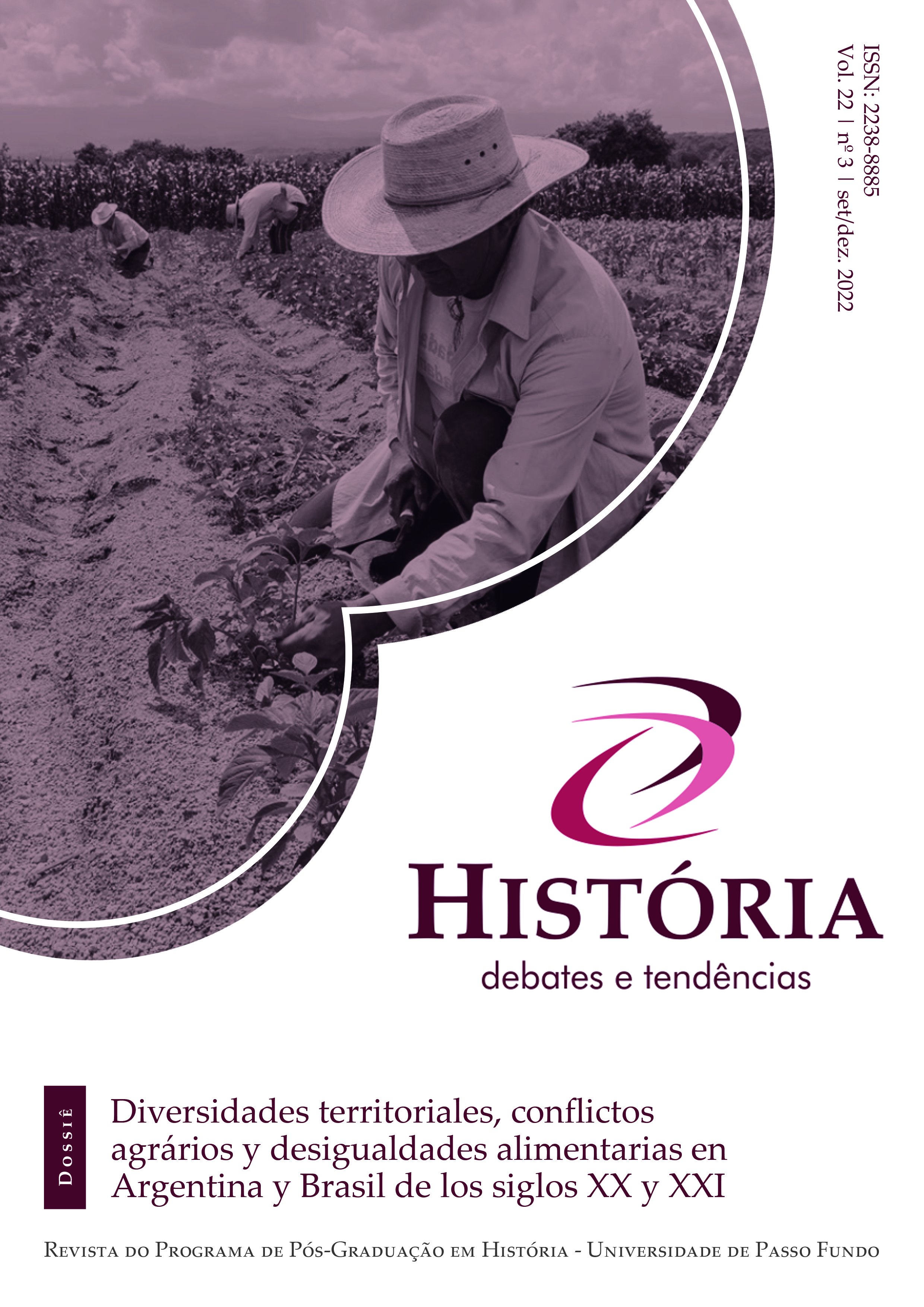Acceso a la comida e injusticia alimentaria:
Revisitando la controversia sobre la crisis alimentaria de 2008 a la luz del 2022.
DOI:
https://doi.org/10.5335/hdtv.22n.3.13711Palavras-chave:
Alimentos, Causas, CriseResumo
No início do século XXI, o setor agroalimentar entrou num ciclo de subida de preços com frequentes crises alimentares. Abordamos criticamente as explicações para as crises de 2008 e 2021/22, a fim de mostrar a dinâmica entre as tendências de médio e curto prazo que estão subjacentes a elas. Ponderamos os principais fatores que contribuem para a explicação e expomos a ligação entre a baixa produtividade do trabalho agrícola, o aumento dos custos associados aos hidrocarbonetos e a procura de biocombustíveis como a combinação que explica centralmente o processo subjacente a ambos os episódios. Nesse quadro, observamos que certos fatores disruptivos no comércio mundial, como a pandemia de COVID-19 ou o conflito russo-ucraniano, bem como complicações climáticas, podem induzir aumentos abruptos de preços ao interagir com as causas de médio prazo mencionadas.
Downloads
Referências
Arezki, R., & Bruckner, M. (2011). Food Prices and Political Instability. IMF Working Papers, 11(62), 1. https://doi.org/10.5089/9781455221066.001
Attinasi, M. G., Bobasu, A., & Gerinovics, R. (2021). What is driving the recent surge in shipping costs? ECB Economic Bulletin (Vol. 3).
Baffes, J., & Dennis, A. (2013). Long-Term Drivers of Food Prices.
Bouët, A., & Laborde Debucquet, D. (2012). Food crisis and export taxation: The cost of non-cooperative trade policies. Review of World Economics, 148(1), 209–233. https://doi.org/10.1007/s10290-011-0108-8
Childs, N., & Kiawu, J. (2009). Factors behind the rise in global rice prices in 2008. ERS/USDA. Recuperado de http://usda01.library.cornell.edu/usda/ers/RCS/2000s/2009/RCS-05-07-2009_Special_Report.pdf
Dawe, D. (2009). The Unimportance of “low” World Grain Stocks for Recent World Price Increases. Recuperado de www.fao.org/es/esa
Deaton, A., & Laroque, G. (1992). On the behaviour of commodity prices. Review of Economic Studies, 59(1), 1–23. https://doi.org/10.2307/2297923
Evenson, R. E., & Gollin, D. (2003). Assessing the impact of the Green Revolution, 1960 to 2000. Science, 300(5620), 758–762. https://doi.org/10.1126/science.1078710
FAO. (2017). The future of food and agriculture: Trends and challenges. Recuperado de http://www.fao.org/publications/card/en/c/d24d2507-41d9-4ec2-a3f8-88a489bfe1ad/
FSIN, & Global Network Against Food Crises. (2021). Global Report on Food Crises 2021. Food Security Information Network. Recuperado de https://www.wfp.org/publications/2020-global-report-food-crises
Gale, F., Valdes, C., & Ash, M. (2019). Interdependence of China, United States, and Brazil in Soybean Trade. Economic Research Service - USDA.
Gallagher, K. P., & Porzecanski, R. (2009). Political Economy Research Institute | China and the Latin America Commodities Boom: A Critical Assessment. Recuperado de www.peri.umass.edu
Georgieva, K., Celasun, O., & Kammer, A. (2022). Supply Disruptions Add to Inflation , Undermine Recovery in Europe. IMF Blog, pp. 1–7.
Ghosh, J. (2010). The Unnatural Coupling: Food and Global Finance. Journal of Agrarian Change, 10(1), 72–86.
Hepburn, J., Laborde, D., Parent, M., & Smaller, C. (2020). COVID-19 and Food Export Restrictions: Comparing today’s situation to the 2007/08 price spikes,”. International Institute for Sustainable Development. Recuperado de https://www.iisd.org/system/files/2020-08/COVID-19-food-export-restrictions.pdf
Hovland, I. (2009). The Food Crisis of 2008: Impact Assessment of IFPRI’s Communications Strategy. Impact Assessment Discussion Paper, December(29), 57.
IFC. (2020). The Impact of COVID-19 on Logistics. International Finance Corporation. Recuperado de https://www.ifc.org/wps/wcm/connect/2d6ec419-41df-46c9-8b7b-96384cd36ab3/IFC-Covid19-Logistics-final_web.pdf?MOD=AJPERES&CVID=naqOED5
Jacks, D. S. (2019). From boom to bust: a typology of real commodity prices in the long run. Cliometrica, 13(2), 201–220. https://doi.org/10.1007/s11698-018-0173-5
Janda, K., & KriÅ¡toufek, L. (2019). The Relationship between Fuel and Food Prices. Annual Review of Resource Economics, 11, 195–216. https://doi.org/10.1146/annurev-resource-100518-094012
Lang, T. (2010). Crisis? What crisis? The normality of the current food crisis. Journal of Agrarian Change, 10(1), 87–97. https://doi.org/10.1111/j.1471-0366.2009.00250.x
Lustig, N. (2008). Working Paper Number 155 November 2008 Thought for Food : The Challenges of Coping with Soaring Food Prices. International Affairs.
Meade, B., Puricelli, E., Mcbride, W., Valdes, C., Hoffman, L., Foreman, L., & Dohlman, E. (2016). Corn and soybean production costs and export competitiveness in Argentina, Brazil, and the United States. Economic Research Service (Vol. EIB-154). Recuperado de www.ers.usda.gov/publications/eib-economic-information-bulletin/eib-154%0ADownload
Minot, N. (2010). Transmission of World Food Price Changes to Markets in Sub-Saharan Africa. Recuperado de http://www.ifpri.org/publication/transmission-world-food-price-changes-markets-sub-saharan-africa
Mitchell, D. (2008). A note on rising food prices (Vol. World Bank). Recuperado de http://www-wds.worldbank.org/external/default/WDSContentServer/IW3P/IB/2008/07/28/000020439_20080728103002/Rendered/PDF/WP4682.pdf
Mittal, A. (2009). The 2008 Food Price Crisis. UNCAD. New York and Geneva.
Roache, S. K. (2010). What Explains the Rise in Food Price Volatility? IMF Working Papers, 10(129), 1. https://doi.org/10.5089/9781455201129.001
Sharples, J., & Martinez, S. (1993). The role of stocks in the world grain market stability. ERS/USDA (Vol. Abril). Washington: USDA.
Shenggen, F., & Headey, D. (2010). Reflections on the global food crisis. Research Report of the International Food Policy Research Institute. Washington, D.C.: IFPRI. https://doi.org/10.1080/03066150.2013.779090
Slayton, T., & Timmer, C. P. (2008). Japan, China and Thailand Can Solve the Rice Crisis. World Trade, (May), 1–6.
Song, X. P., Hansen, M. C., Potapov, P., Adusei, B., Pickering, J., Adami, M., … Tyukavina, A. (2021). Massive soybean expansion in South America since 2000 and implications for conservation. Nature Sustainability, 4(9), 784–792. https://doi.org/10.1038/s41893-021-00729-z
Trigo, E. (2016). Veinte años de cultivos genéticamente modificados en la agricultura argentina.
Trostle, R. (2008). Global agricultural supply and demand: Factors contributing to the recent increase in food commodity prices (Vol. WRS-0801).
United Nations. (2011). The Global Social Crisis: Report on the World Social Situation 2011. Recuperado de http://www.un.org/esa/socdev/rwss/docs/2011/rwss2011.pdf
Walh, P. (2009), Food Speculation: the main factor of the price bubble in 2008, Berlin, WEED.
Walsh, J. P. (2011). Reconsidering the Role of Food Prices in Inflation. IMF Working Papers, 11(71), 1. https://doi.org/10.5089/9781455227082.001
World Bank Group. (2014). Food Price Watch.
Zilberman, D., Hochman, G., Rajagopal, D., Sexton, S., & Timilsina, G. (2013). The impact of biofuels on commodity food prices. American Journal of Agricultural Economics, 95(2), 275–281. https://doi.org/10.1093/ajae/aas037






